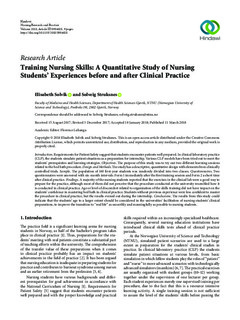| dc.contributor.author | Solvik, Elisabeth | |
| dc.contributor.author | Struksnes, Solveig Kr | |
| dc.date.accessioned | 2019-09-24T07:20:11Z | |
| dc.date.available | 2019-09-24T07:20:11Z | |
| dc.date.created | 2019-09-23T10:15:05Z | |
| dc.date.issued | 2018 | |
| dc.identifier.citation | Nursing Research and Practice. 2018, 2018 . | nb_NO |
| dc.identifier.issn | 2090-1429 | |
| dc.identifier.uri | http://hdl.handle.net/11250/2618352 | |
| dc.description.abstract | Introduction. Requirements for Patient Safety suggest that students encounter patients well prepared. In clinical laboratory practice (CLP), the students simulate patient situations as a preparation for internship. Various CLP models have been tried out to meet the students’ prerequisites and learning strategies. Objectives. The purpose of this study was to try out two different learning sessions related to the bed bath procedure. Design and Methods. The study has a descriptive, quantitative design with elements from clinically controlled trials. Sample. The population of 160 first-year students was randomly divided into two classes. Questionnaires. Two questionnaires were answered with six-month intervals: Form 1 immediately after the first training session and Form 2 a short time after clinical practice. Findings. A majority of the nursing students reported that the exercises in the clinical lab were a good way to prepare for the practice, although most of them did not perceive that the procedure conducted at the university resembled how it is conducted in clinical practice. Age or level of discomfort related to organization of the skills training did not have impact on the students’ confidence in mastering bed bath in clinical practice. Students without previous experience were less confident to master the procedure in clinical practice, but the results evened out during the internship. Conclusions. The results from this study could indicate that the students’ age to a larger extent should be considered in the universities’ facilitation of nursing students’ clinical preparations, to improve the transition to “real life” as smoothly and meaningfully as possible to nursing students. | nb_NO |
| dc.language.iso | eng | nb_NO |
| dc.publisher | Hindawi | nb_NO |
| dc.rights | Navngivelse 4.0 Internasjonal | * |
| dc.rights.uri | http://creativecommons.org/licenses/by/4.0/deed.no | * |
| dc.title | Training Nursing Skills: A Quantitative Study of Nursing Students’ Experiences before and after Clinical Practice | nb_NO |
| dc.type | Journal article | nb_NO |
| dc.type | Peer reviewed | nb_NO |
| dc.description.version | publishedVersion | nb_NO |
| dc.source.pagenumber | 9 | nb_NO |
| dc.source.volume | 2018 | nb_NO |
| dc.source.journal | Nursing Research and Practice | nb_NO |
| dc.identifier.doi | 10.1155/2018/8984028 | |
| dc.identifier.cristin | 1727666 | |
| dc.description.localcode | Copyright © 2018 Elisabeth Solvik and Solveig Struksnes. This is an open access article distributed under the Creative Commons Attribution License, which permits unrestricted use, distribution, and reproduction in any medium, provided the original work is properly cited. | nb_NO |
| cristin.unitcode | 194,65,70,0 | |
| cristin.unitname | Institutt for helsevitenskap Gjøvik | |
| cristin.ispublished | true | |
| cristin.fulltext | original | |
| cristin.qualitycode | 1 | |

